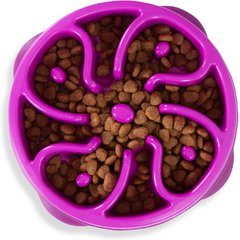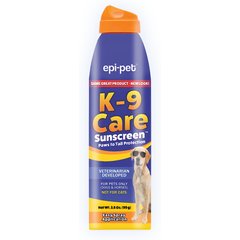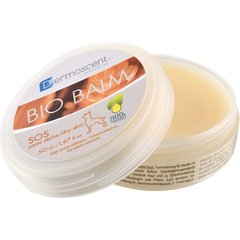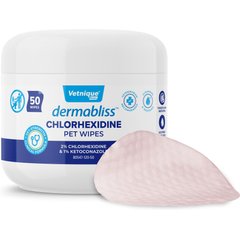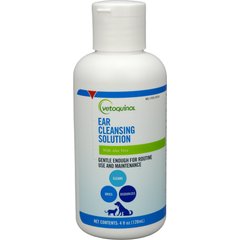American Hairless Terrier
lenanet/iStock / Getty Images Plus via Getty Images
No hair? No problem. That’s a sentiment shared by those who love the American Hairless Terrier, the only hairless dog breed native to the U.S.
This is also a relatively new dog breed—American Hairless Terriers only date back to the ’70s, when a hairless puppy was born into a litter of Rat Terriers, according to the American Hairless Terrier Club of America (AHTCA).
Standing 12–16 inches tall and weighing between 12 and 28 pounds, American Hairless Terriers are intelligent, high-energy, and playful dogs. They may also be a good fit for some people with allergies and are sometimes considered to be hypoallergenic dogs (though there’s really no such thing).
Caring for an American Hairless Terrier

Though the cute American Hairless Terrier doesn’t have any fur (aside from eyebrows and whiskers found on some pups), that doesn’t mean these dogs don’t need grooming. It’s important to keep their skin moisturized, protected from hazards, and clean. Special care should also be paid to their teeth, ears, and nails.
Regular exercise and mental stimulation are other musts for this breed—without them, these smart dogs with abundant energy can develop undesirable and destructive behaviors, like digging, to keep themselves entertained.
These dogs can be great playmates for children thanks to their rambunctious energy. Overall, American Hairless Terriers are a lively, intelligent, and friendly breed, and their small size makes them great apartment dogs.
American Hairless Terrier Health Issues
American Hairless Terriers are typically healthy dogs who live for 14–16 years on average. However, like all dog breeds, some may experience health issues.
To minimize risk for some diseases, purchase an American Hairless Terrier puppy from a reputable breeder and keep up with regular veterinary wellness exams.
Patella Luxation
A common condition in small-breed dogs, patella luxation is characterized by the kneecap no longer sitting properly in the knee joint—it moves (luxates) to either side as a dog walks or runs. Mild cases may only be noticed by your veterinarian during a physical exam, while more severe cases may result in a bunny-hopping gait.
Many cases of patella luxation are managed medically with joint supplements and weight management. However, severe cases may need surgery to correct.
Heart Disease
American Hairless Terriers can develop heart disease, particularly as they get older. The first sign may be a heart murmur your veterinarian detects, but symptoms can also include:
-
Fatigue
-
Fainting from excitement or exercise
It’s also possible for a dog to have heart problems that show no symptoms.
Work with your veterinarian to manage your American Hairless Terrier’s heart disease. Your dog may need changes to their diet and exercise routine, and lifelong medications are sometimes prescribed.
Primary Lens Luxation
The lens is a small, clear disc inside the eye that helps dogs see by focusing light on the retina. Primary lens luxation is when the lens falls out of its normal position, and the condition commonly occurs when affected dogs are 3–8 years old.
Symptoms include tearing, squinting, and cloudiness in the eye. The condition can be treated with surgery.
What To Feed an American Hairless Terrier
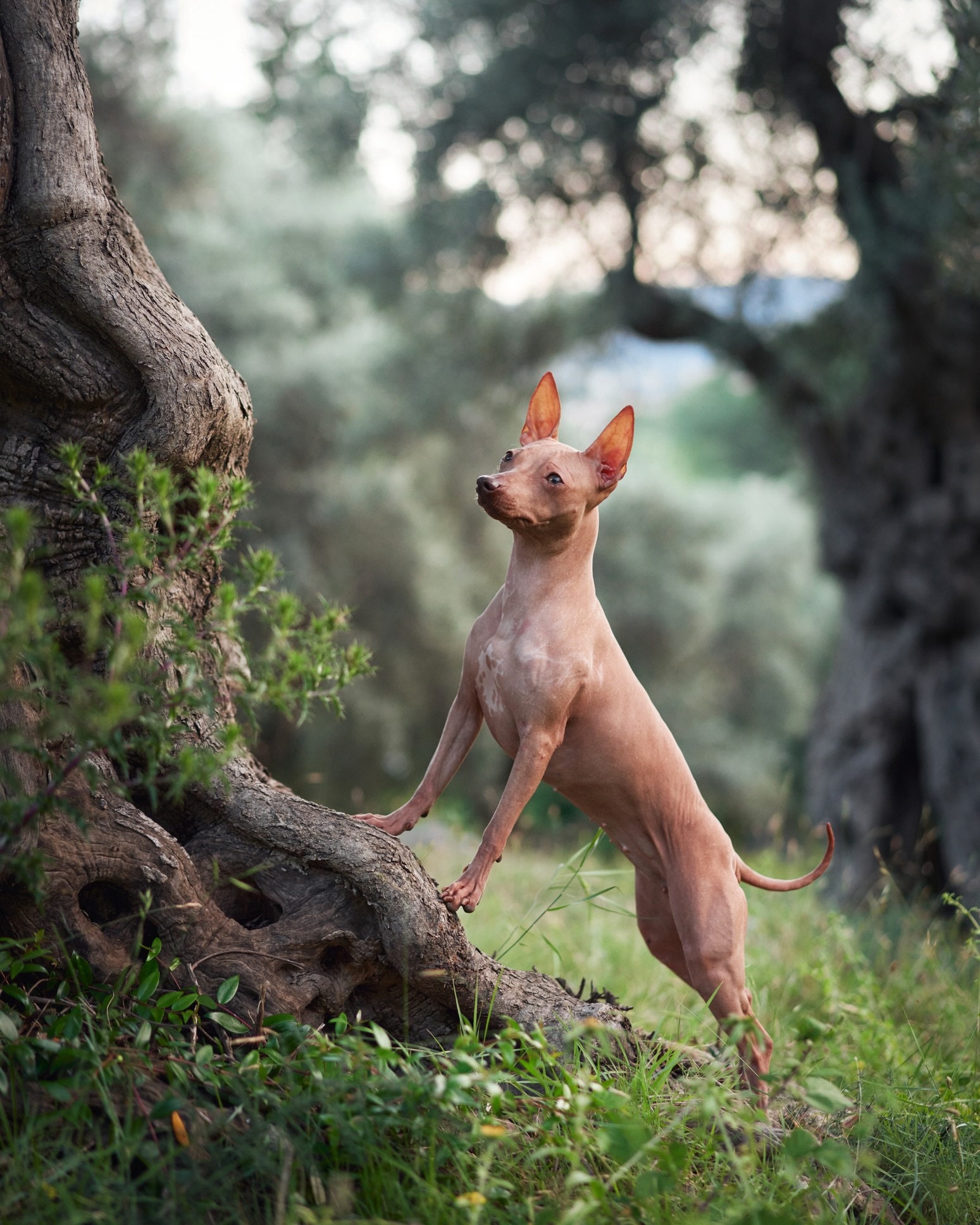
American Hairless Terriers need to eat a dog food that meets Association of American Feed Control Officials (AAFCO) nutritional guidelines. American Hairless Terrier puppies should eat a puppy-specific food until they’re 1 year old, when they can transition to adult food.
How To Feed an American Hairless Terrier
American Hairless Terrier puppies under 4 months old will benefit from frequent, small meals (four or five per day) to avoid low blood sugar, which can be seen in small-breed puppies.
Once your American Hairless Terrier is fully grown, two meals a day should be enough to keep them healthy and satisfied. To give them some of the mental stimulation they need, consider using a puzzle feeder to keep your dog busy while they eat.
Recommended Products
How Much Should You Feed an American Hairless Terrier?
A dog’s exact calorie requirements depend on their age, health, lifestyle, and other factors. Because American Hairless Terriers are a small breed, it’s important to keep them at a healthy weight to avoid orthopedic and metabolic issues as they age.
Your dog’s food packaging has a feeding guide that typically recommends the total amount of food that should be given in a 24-hour period. You can use this as a general guide, but always talk to your veterinarian for the best advice about your specific pooch.
Nutritional Tips for American Hairless Terriers
Dogs who eat an AAFCO-compliant dog food should receive all the nutrients they need. But because American Hairless Terriers can develop joint and eye issues, your vet may prescribe certain dog supplements depending on your particular pup’s needs.
Talk to your veterinarian if you have any concerns about your dog’s nutrition, and never give your pet a supplement without a vet’s oversight.
Behavior and Training Tips for American Hairless Terriers
American Hairless Terrier Personality and Temperament
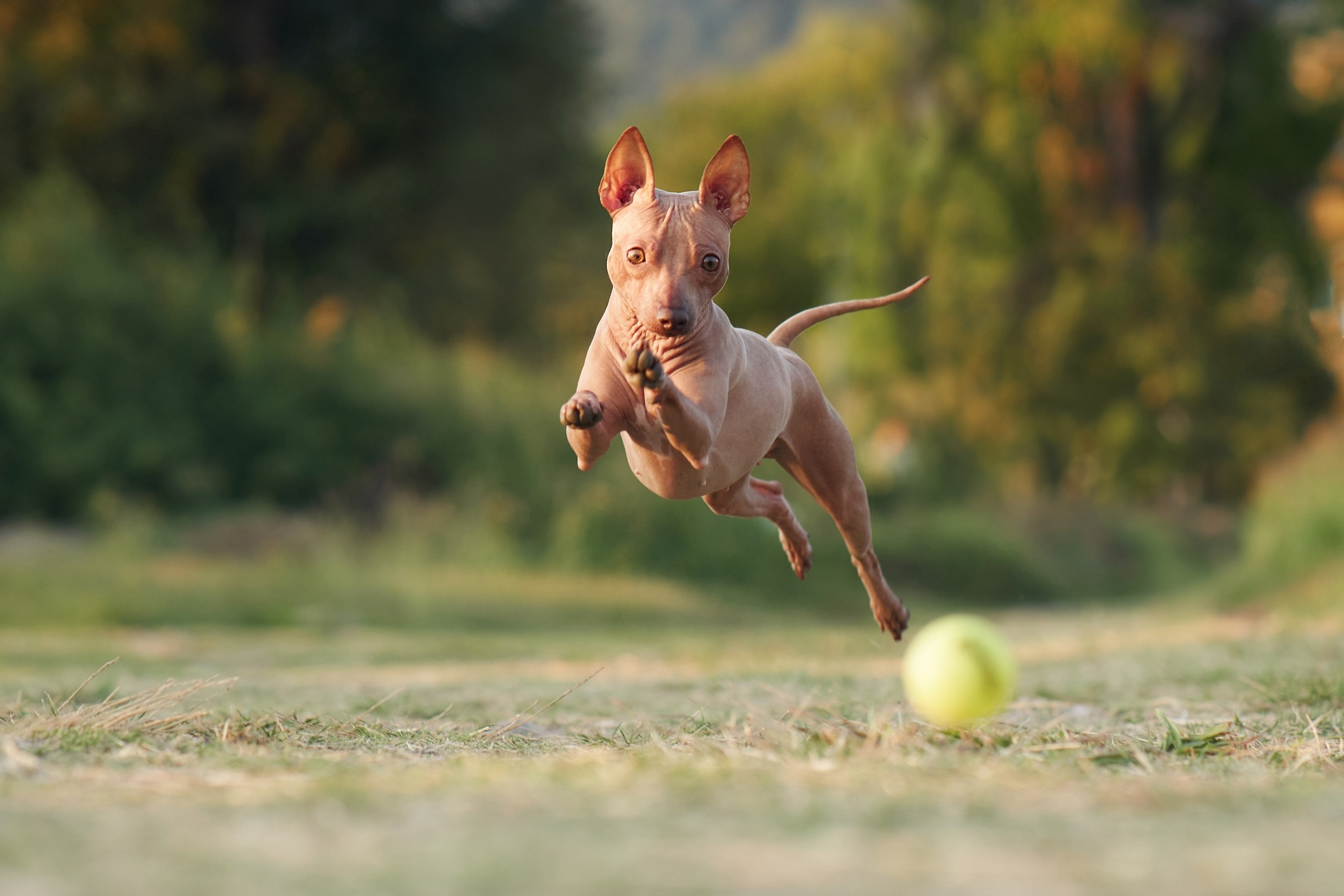
American Hairless Terriers are known to be intelligent and full of energy. While they’re content being indoor lap dogs, they still require regular exercise. They’re very trainable, so keeping their mind occupied with obedience and trick training is a good place to start.
According to the AHTCA, these dogs generally get along well with children. But it’s still important to supervise young children at all times with any dog, regardless of breed, and to teach kids how to appropriately interact with small pets like the American Hairless Terrier.
American Hairless Terrier Behavior
Like all terrier dog breeds, American Hairless Terriers are known to be affectionate, playful, and inquisitive. Regular walks and indoor playtime will keep them happy.
Also like all terriers, these dogs can be watchful and bark to alert their family to visitors or strange noises. Proper training, exercise, and mental stimulation can help reduce excess barking.
American Hairless Terrier Training
The American Hairless Terrier’s temperament lends itself well to training because they are energetic and eager to please. They thrive with obedience and agility training. Keep your training sessions short and full of positive reinforcement.
Begin socializing your American Hairless Terrier puppy as soon as you bring them home. Puppies who are exposed to new people, places, animals, and experiences will be better adjusted and more confident in new situations throughout their life. A properly socialized American Hairless Terrier will do well around new people and with other pets.
Fun Activities for American Hairless Terriers
-
Agility
-
Obedience training
-
Walking
-
Puzzle toys
-
Cuddling on the couch
American Hairless Terrier Grooming Guide
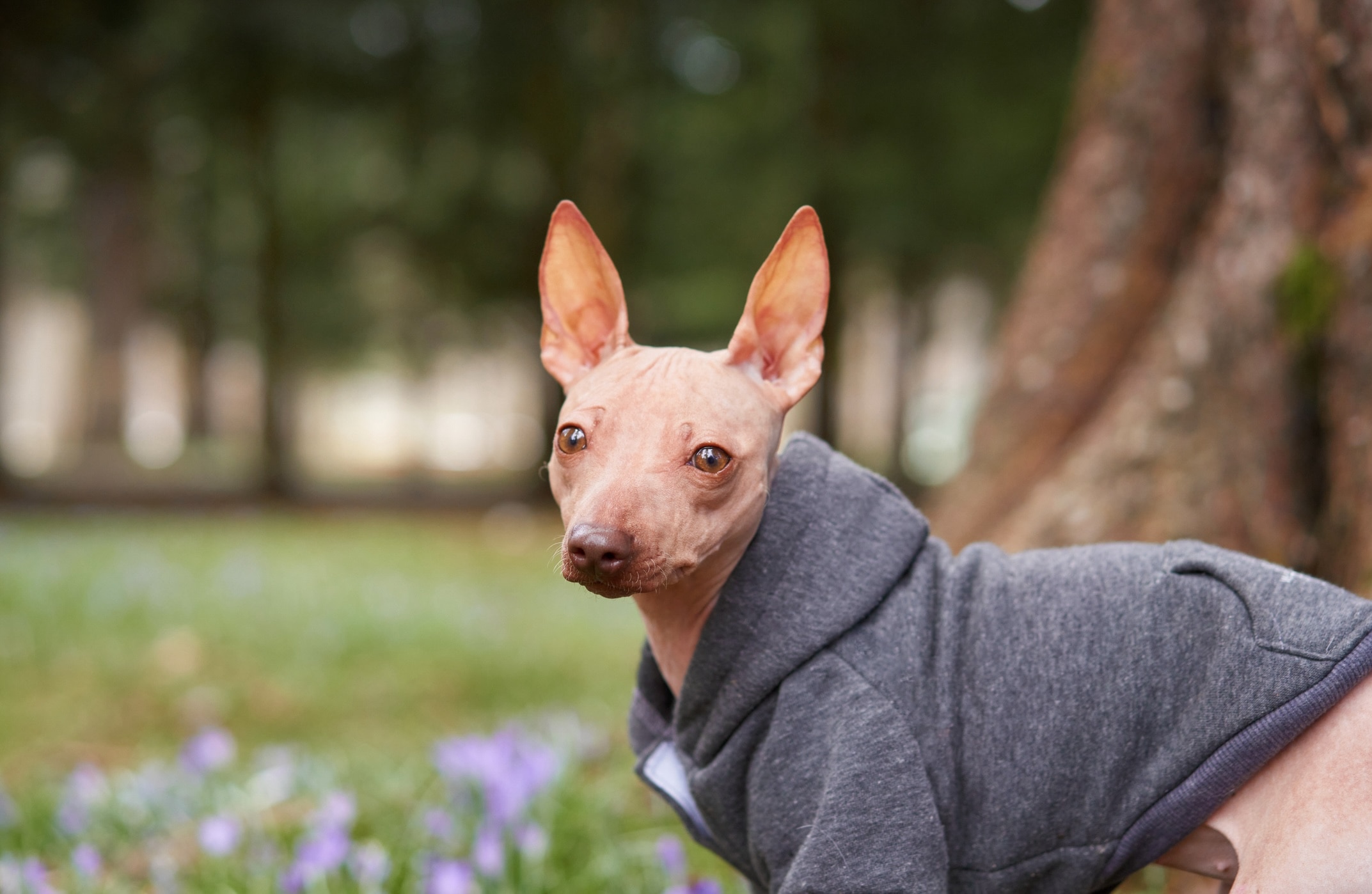
Because they lack a full coat, American Hairless Terriers don’t require the grooming routine many other dog breeds have. However, their skin needs regular attention. (Fun fact: They’re one of the few dogs who can sweat!)
Skin Care
Because their bare skin makes them more exposed to the elements, hairless dogs like the American Hairless Terrier need a regular skin care routine.
To avoid sunburns, protect their skin with dog-friendly sunscreen or by blocking the sun’s rays with clothing. They also get cold easily when the temperature drops, so keep them warm with a doggy sweater or coat when outdoors and a blanket when indoors.
To avoid skin issues, American Hairless Terriers also need regular baths, preferably every week. Use lukewarm water and mild shampoo, and inspect them for dry spots, redness, or flaky areas on their skin. Keeping their skin moisturized is also important; use dog-friendly lotion or cream.
Your American Hairless Terrier might also be prone to ache. Using medicated wipes can help with skin infections, including acne. Talk with your vet to see how you can help reduce acne on your dog.
Recommended Products
Eye Care
American Hairless Terriers shouldn’t need special eye care. But if you see your dog pawing at their eye, squinting, or having eye discharge, take them to the vet to check for an eye infection.
Ear Care
Keep an eye out for ear-scratching, head-shaking, discharge, or a bad smell coming from your American Hairless Terrier’s ears—these can all be signs of an ear infection. To prevent infections, ask your vet how often you should clean your dog’s ears and get recommendations for ear-cleaning products.
Recommended Products
Considerations for Pet Parents
The American Hairless Terrier makes an excellent companion, whether you’re in a house or apartment. Just be sure to give them regular exercise and mental stimulation, whether that’s a puzzle feeder, a daily walk through the neighborhood, or a run through a fun agility course.
With proper socialization and early training, these terriers are friendly and affectionate dogs. Just remember that, due to their hairlessness, they require a more involved skin care routine than other breeds—but no coat care.
American Hairless Terrier FAQs
Are American Hairless Terriers good pets?
Yes, a well-trained, socialized, and mentally stimulated American Hairless Terrier makes a great pet. They’re content both outside enjoying activities and inside curling up next to their humans.
Are American Hairless Terriers cuddly?
Yes, they definitely can be! They’re known to be very affectionate terriers who form strong bonds with their pet parents.
Do American Hairless Terriers bark a lot?
American Hairless Terriers can be vocal, especially around strange noises or humans they don’t already know. This is why training is important to curb unwanted behaviors, such as excessive barking.

